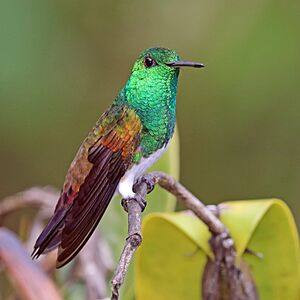Snowy-bellied hummingbird facts for kids
The snowy-bellied hummingbird (Saucerottia edward) is a small, colorful bird. It is also sometimes called the snowy-breasted hummingbird. This hummingbird belongs to a group of birds known as "emeralds." You can find it mostly in Costa Rica and Panama, with a few sightings in Colombia.
Quick facts for kids Snowy-bellied hummingbird |
|
|---|---|
 |
|
 |
|
| In Mount Totumas cloud forest, Panama Images show how 'color' of feathers changes with lighting |
|
| Conservation status | |
| Scientific classification | |
| Genus: |
Saucerottia
|
| Species: |
edward
|
 |
|
| Range of S. edward | |
| Synonyms | |
|
Amazilia edward |
|
Contents
How Scientists Classify This Bird
Scientists group living things into categories. This helps us understand how different species are related. The snowy-bellied hummingbird used to be in a group called Amazilia.
However, a study in 2014 looked closely at the birds' DNA. This study showed that the Amazilia group was not as clear-cut as once thought. Because of this, most scientists moved the snowy-bellied hummingbird to a different group. This new group is called Saucerottia. Some groups, like BirdLife International, still use the old name.
There are four types, or subspecies, of the snowy-bellied hummingbird:
- S. e. niveoventer
- S. e. edward
- S. e. collata
- S. e. margaritarum
Some people have suggested that S. e. niveoventer might be its own species. This is because of the color of its tail. But this idea has not been widely accepted by scientists.
What the Snowy-Bellied Hummingbird Looks Like
The snowy-bellied hummingbird is about 8 to 11 centimeters (3 to 4 inches) long. Males weigh about 5 to 5.4 grams. Females are a bit lighter, weighing 4.3 to 5.2 grams.
Both male and female birds have a straight, blackish bill. The bottom part of their bill is reddish. Adult males of the S. e. edward subspecies have bronze-green upper parts. Their back and rump can look coppery. Their tail is bronze to coppery and sometimes has a purple shine. Their throat and chest are a shiny golden green. The belly has a V-shaped white center. The feathers under their tail are a reddish-brown color.
Female birds look similar to males. However, the green on their upper parts is not as bright. Their throat and the feathers under their tail are whiter. The outer tail feathers also have light green tips.
Each subspecies has slight differences:
- S. e. niveoventer is a little larger. Its tail is bluish-black or purplish-black.
- S. e. collata has less contrast between the green and copper on its back. Its undertail feathers are brownish.
- S. e. margaritarum has paler undertail feathers. Its tail is bronze to bronze-green.
Where the Snowy-Bellied Hummingbird Lives
The different subspecies of the snowy-bellied hummingbird live in specific areas:
- S. e. niveoventer lives in southwestern Costa Rica and western and central Panama. This includes Coiba Island.
- S. e. edward is found in Panama, from the Canal Zone east to Darién Province. It has also been seen in northwestern Colombia.
- S. e. collata lives in central Panama.
- S. e. margaritarum is found in southwestern Darién, the Pearl Islands, and other islands in the Gulf of Panama.
This hummingbird lives in many different places. In Costa Rica and western Panama, it likes open areas. These include savannas, scrublands with trees, and the edges of forests. It also lives in coffee farms and gardens. It can be found from sea level up to 1,600 meters (5,200 feet) high.
S. e. collata lives in fields with low plants and bushes. It prefers elevations between 500 and 850 meters (1,600 to 2,800 feet). On islands, S. e. margaritarum lives in open areas like old fields and also in mangrove forests. On the mainland, it lives in rainforests. It can be found from sea level up to 700 meters (2,300 feet).
Behavior
Movement
The snowy-bellied hummingbird usually stays in one area. However, it does move locally. For example, it might move from dry areas in the wet season to more humid places in the dry season. It also seems to move to find flowers when they are blooming.
Feeding
This hummingbird drinks nectar from many different types of plants, shrubs, and trees. It usually feeds about 3 to 6 meters (10 to 20 feet) off the ground. Sometimes, it will protect its favorite feeding spots from other birds. Besides nectar, it also eats small arthropods. It catches these insects by flying out from a perch. It also picks them off leaves.
Reproduction
In the western parts of its range, the snowy-bellied hummingbird breeds between September and January. Most nesting happens in December and January. The nest is shaped like a cup. It is made of soft fibers and covered with lichens and moss. The bird usually places its nest on a branch or in the fork of a bush or small tree. Nests can be up to 9 meters (30 feet) above the ground. The female bird lays two eggs and sits on them to keep them warm. We do not know how long the eggs take to hatch or when the young birds leave the nest.
Vocalization
The song of the snowy-bellied hummingbird sounds like "a soft 'bebeebee, d’beebee' or 'tseer tir tir'." It also makes short "tip" or "tsip" calls.
Conservation Status
The IUCN (International Union for Conservation of Nature) has listed the snowy-bellied hummingbird as a species of "Least Concern." This means that it is not currently in danger of disappearing. It lives across a large area. Its population is believed to be stable, with at least 50,000 adult birds. Scientists have not found any immediate threats to this species. It is common in most places where it lives, including the islands. However, it is less common in eastern Panama.


